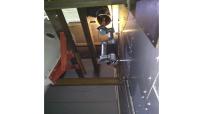
DALLAS, Aug. 11, 2020 /PRNewswire/ -- Jacobs (NYSE:J) is deploying a new type of Raman spectroscopy technology, which makes it safer and cheaper to spot radioactive contamination or other hazardous substances in waste stores and nuclear facilities undergoing decommissioning.
Raman spectroscopy1 – which works by firing lasers at a target and measuring the resulting molecular vibrations – is one of the most effective techniques for identifying specific chemical compounds. But it is rarely used in nuclear decommissioning, where access constraints and high radiation fields can prevent the spectrometer from working at its typical effective range.
However, a team from Jacobs and IS Instruments, based in Kent, U.K, designed a new type of Raman system which can still detect a weak laser signal when several meters from the target. In addition, the team found a way to mount the Raman probe onto either a remotely operated vehicle or robot arm. This enables the probe to get within two meters of the target and send a signal down an optical cable to the main Raman instrument, safely positioned tens of meters away.
"Standard equipment often cannot detect specific chemical agents, either because it can't get close enough or because the signals are crowded out by the overall radiation levels," said Jacobs Critical Mission Solutions International Senior Vice President Clive White. "This new type of Raman system is an important breakthrough for the nuclear industry because it provides greater certainty about the presence of hazardous materials in high radiation waste facilities, making the materials easier, cheaper and safer to detect."
Jacobs and Innovate UK, a U.K. government agency, have provided funding to take the system from proof-of-concept to commercial application. It is now being used to detect uranium and also substances such as kerosene and tri-butyl phosphate, which are used in reprocessing operations and can indicate the presence of plutonium or uranium contamination.
Legacy nuclear facilities sometimes contain significant amounts of poorly unidentified or unknown waste materials, so improved characterization capability can reduce decommissioning costs and timescales.
Raman technology is also a key feature of a new integrated decommissioning system built by Jacobs, which won a recent U.K. Government-funded innovation competition and will be demonstrated inside highly radioactive former fuel reprocessing facilities at Sellafield later this year.
Outside of the nuclear sector, this advance in Raman technology will be a valuable tool in areas where human access is impossible or problematic.
At Jacobs, we're challenging today to reinvent tomorrow by solving the world's most critical problems for thriving cities, resilient environments, mission-critical outcomes, operational advancement, scientific discovery and cutting-edge manufacturing, turning abstract ideas into realities that transform the world for good. With $13 billion in revenue and a talent force of more than 55,000, Jacobs provides a full spectrum of professional services including consulting, technical, scientific and project delivery for the government and private sector. Visit jacobs.com and connect with Jacobs on Facebook, Instagram, LinkedIn and Twitter.
Certain statements contained in this press release constitute forward-looking statements as such term is defined in Section 27A of the Securities Act of 1933, as amended, and Section 21E of the Securities Exchange Act of 1934, as amended, and such statements are intended to be covered by the safe harbor provided by the same. Statements made in this release that are not based on historical fact are forward-looking statements. We base these forward-looking statements on management's current estimates and expectations as well as currently available competitive, financial and economic data. Forward-looking statements, however, are inherently uncertain. There are a variety of factors that could cause business results to differ materially from our forward-looking statements, including, but not limited to, the impact of the COVID-19 pandemic and the related reaction of governments on global and regional market conditions and the company's business. For a description of some additional factors that may occur that could cause actual results to differ from our forward-looking statements, see our Annual Report on Form 10-K for the year ended September 27, 2019, and in particular the discussions contained under Item 1 - Business; Item 1A - Risk Factors; Item 3 - Legal Proceedings; and Item 7 - Management's Discussion and Analysis of Financial Condition and Results of Operations, and our Quarterly Report on Form 10-Q for the quarter ended June 26, 2020, and in particular the discussions contained under Part I, Item 2 - Management's Discussion and Analysis of Financial Condition and Results of Operations; Part II, Item 1 - Legal Proceedings; and Part II, Item 1A - Risk Factors, as well as the company's other filings with the Securities and Exchange Commission. The company is not under any duty to update any of the forward-looking statements after the date of this press release to conform to actual results, except as required by applicable law.
For press/media inquiries:
Kerrie Sparks
214.583.8433
1 https://is-instruments.com/background-science/what-is-raman-spectroscopy/
View original content to download multimedia:http://www.prnewswire.com/news-releases/jacobs-deploys-scientific-breakthrough-in-radioactive-and-hazardous-substance-contamination-monitoring-301109228.html
SOURCE Jacobs












































